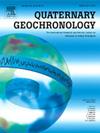First luminescence dating of exhumed fault-zone rocks of the North Tehran Fault, Iran
Abstract
Here we report luminescence dating results on exhumed fault rocks from the North Tehran Fault (NTF, Iran), including the fault gouges. The NTF is an oblique-dip thrust fault expanding from west to east at the northern fringe of the megacity of Tehran. Although the fault is known to be active and a major threat to the city, only little is known about its earthquake history. We present first data on the timing of past fault motion using dating of fault rocks. Three sites have been selected for this study in which the fault damage zone is associated with Eocene volcaniclastic rocks (Karaj Formation). The fault gouge, transitional and damage zone were sampled for which we observed slip planes in the field. The fault rocks are composed of quartz and alkali feldspar favourable for luminescence dating. However, our study reveals that the quartz optically stimulated luminescence (OSL) signal of the Karaj Formation does not seem to have a measurable fast decaying signal component. Instead, the post-infrared stimulated luminescence at 225 °C (pIRIRSL225) of polymineral fine-grain fraction appears to be the most feasible signal for these samples. The first luminescence-based results presented here comprise an age range from 45 ± 5 ka to 72 ± 13 ka for fault gouges and transitional zone. Since dating the transitional zone close to the fault gouge led to a younger age than the fault gouge at one site, we conclude that the sampling location plays a crucial role in dating exhumed fault rock using luminescence dating. The obtained ages are far older than those of the previous palaeoseismological studies that dated earthquake-related sedimentary features in the region. Therefore, more research is required to shed light on the resetting mechanism and condition of these fault rocks due to the recent activity of the NTF.

 求助内容:
求助内容: 应助结果提醒方式:
应助结果提醒方式:


